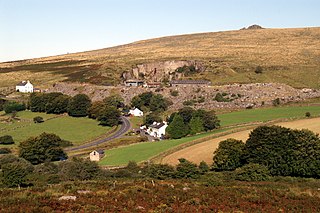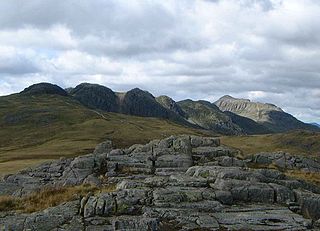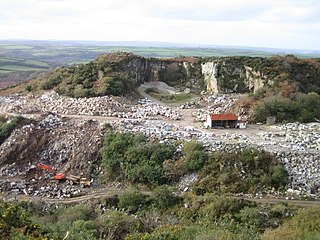
The Ravenglass and Eskdale Railway is a 15 in minimum gauge heritage railway in Cumbria, England. The 7-mile (11.3 km) line runs from Ravenglass to Dalegarth Station near Boot in the valley of Eskdale, in the Lake District. At Ravenglass the line ends at Ravenglass railway station on the Cumbrian Coast Line.

Merrivale is a locality in western Dartmoor, in the West Devon district of Devon, England. It is best known for the nearby series of Bronze Age megalithic monuments to the south and a former granite quarry.

Crinkle Crags is a fell in the English Lake District in the county of Cumbria. It forms part of two major rings of mountains, surrounding the valleys of Great Langdale and Upper Eskdale. The name reflects the fell's physical appearance as its summit ridge is a series of five rises and depressions (crinkles) that are very distinctive from the valley floor. In Old English, cringol means twisted or wrinkled.

The River Esk, sometimes called the Cumbrian Esk, is a river in Cumbria, England. It flows for approximately 25 km from its source in the Scafells range of mountains to its estuary at Ravenglass. The valley it flows through is known as Eskdale. It is one of two Rivers Esk in Cumbria, and not to be confused with the Border Esk which flows into Cumbria from Scotland.

Treverbyn is a civil parish and village in mid-Cornwall, England, United Kingdom, lying north of St Austell.

De Lank Quarries is an active quarry and a 54-acre geological Site of Special Scientific Interest in St Breward parish, north Cornwall, England, UK. The quarry, which received its SSSI notification in 1994, takes its name from the nearby De Lank river. The quarry produces typical biotite granites and are of such quality that a slab now forms the base section of the reception desk at the Geological Society of London. Other notable structures built of De Lank granite are the fourth Eddystone Lighthouse, 1882; the Royal Opera House in Covent Garden, London and the New Parliamentary Building in Whitehall, London
Shap Fells is a Site of Special Scientific Interest part of which is within the Lake District National Park in Cumbria, England. It is located near the eastern boundary of the park, with one section to the west of the A6 road and another section to the east of this road. Throughout the protected area there are areas of blanket bog. Shap Fells was designated as a Site of Special Scientific Interest because of the range of acid grassland types, the diversity of upland birds and also because of geological features. Shap Pink Quarry is included in the western section of this protected area
The Flits is a Site of Special Scientific Interest (SSSI) near Holywell, six miles west of Hereford in Herefordshire, England. This protected area is also a National Nature Reserve.
Bushy Hazels & Cwmma Moors is a Site of Special Scientific Interest (SSSI) near Eardisley in Herefordshire, England. This protected area contains patches of ancient woodland.
Fishpool Valley is a Site of Special Scientific Interest (SSSI) near Yarpole, Herefordshire, England. This protected area is an area of woodland that is important because of its bird diversity. This protected area is within the Croft Castle estate, owned by the National Trust.
Haugh Wood is a Site of Special Scientific Interest near Woolhope in Herefordshire, England. The protected area is recognised for its diversity of its insects. The Forestry Commission has provided waymarked butterfly trails in this protected area.
Cottonshope Head Quarry is a Site of Special Scientific Interest within Northumberland National Park, Northumberland, England. It is located north of the hamlet of Cottonshopeburnfoot. The site is an abandoned quarry within a military training area.
Greenleighton Quarry is a Site of Special Scientific Interest (SSSI) in Northumberland, England. It is located near the village of Rothley. This protected area is renowned for its Brachiopod fossils and is owned by the National Trust.
Stawardpeel Woods is a Site of Special Scientific Interest (SSSI) in Northumberland, England. This protected area is located in the valley of the River Allen, near Bardon Mill. The protected area is owned by the National Trust, within the Allen Banks & Staward Gorge estate.
Ashgill Quarry is a Site of Special Scientific Interest within Lake District National Park in Cumbria, England. It is located near Coniston Water, near the village of Torver on the slopes of the mountain called the Old Man of Coniston. This protected area is important for the Ordovician rocks exposed here. The protected area includes several quarries
Birk Fell Hawse Mine is a Site of Special Scientific Interest (SSSI) within the Lake District National Park in Cumbria, England. It is located on the Tilberthwaite Fells, near Wetherlam mountain, close to Little Langdale. This protected area has been designated because of the geology of the area.
Buttermere Fells is a Site of Special Scientific Interest (SSSI) within Lake District National Park in Cumbria, England. The protected area includes many of the hills and mountains between the Buttermere lake valley near the village of Buttermere and the River Derwent valley near the village of Braithwaite. This protected area includes the mountains of Grasmoor, Crag Hill, Causey Pike and Hindscarth. The protected area includes much of the North Western Fells. This protected area contains exceptional examples of montane dwarf shrub heath communities.
Farleton Knott is a Site of Special Scientific Interest (SSSI) in Cumbria, England. It is located 6km west of Kirkby Lonsdale, near Farleton. This protected area includes an exceptional limestone pavement on the top of a hill called Farleton Fell. Farleton Knott SSSI includes within its boundary Newbiggin Crags, Holme Park Fell and a National Nature Reserve called Clawthorpe Fell.
Milkingstead Wood is a Site of Special Scientific Interest (SSSI) within the Lake District National Park in Cumbria, England. It is located 1km south east of Eskdale Green in the valley of the River Esk (Eskdale). This site is important because of the fern species present.
Miterdale Head Wood is a Site of Special Scientific Interest (SSSI) within the Lake District National Park, in Cumbria, England. It is 3km east of Santon Bridge near Eskdale. This hazel-birch woodland is protected because of its exceptional diversity of moss and liverwort species.






